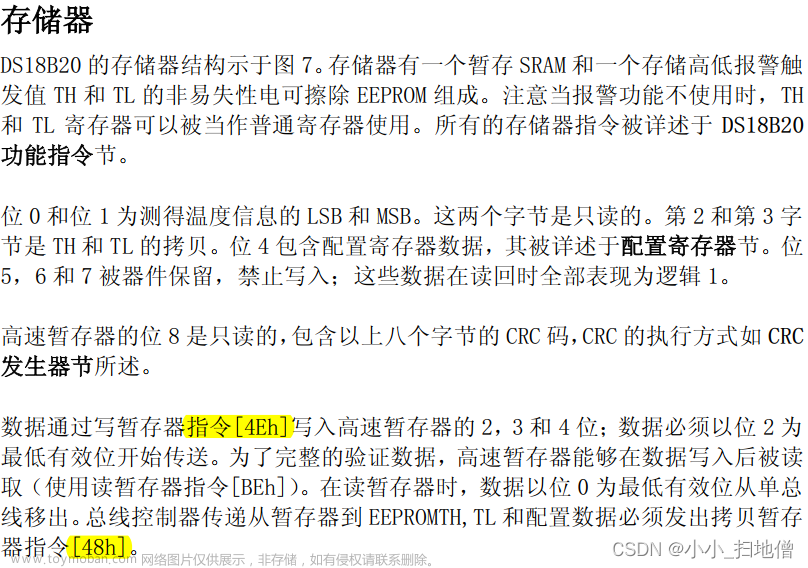
需要先编写OneWire模块,再在DS18B20模块中调用OneWire模块的函数
先根据原理图做好端口的声明:
sbit OneWire_DQ = P3^7;
接下来像之前一样把时序结构用代码模拟出来:
unsigned char OneWire_Init(void)
{
unsigned char i;
unsigned char AckBit;
OneWire_DQ = 1;
OneWire_DQ = 0; //总线拉低
//延时500us
i = 227; while (--i);
OneWire_DQ = 1; //释放总线
//延时70us
i = 29; while (--i);
AckBit = OneWire_DQ;
//延时500us
i = 227; while (--i);
return AckBit;
}

void OneWire_SendBit(unsigned char Bit)
{
unsigned char i;
OneWire_DQ = 0; //总线拉低
//延时10us后直接读电平
i = 4; while(--i);
OneWire_DQ = Bit;
//延时50us凑满时间片
i = 22; while(--i);
OneWire_DQ = 1;
}

unsigned char OneWire_ReceiveBit(void)
{
unsigned char i;
unsigned char Bit;
OneWire_DQ = 0;
//延时5us
i = 2; while(--i);
OneWire_DQ = 1;
//延时5us
i = 2; while(--i);
Bit = OneWire_DQ;
//延时50us
i = 22; while(--i);
return Bit;
}

void OneWire_SendByte(unsigned char Byte)
{
unsigned char i;
for(i = 0; i < 8; i ++) {
OneWire_SendBit(Byte & (0x01<<i));
}
}
unsigned char OneWire_ReceiveByte(void)
{
unsigned char i;
unsigned char Byte = 0x00;
for(i = 0; i < 8; i ++) {
if(OneWire_ReceiveBit()) {Byte |= (0x01<<i);}
}
return Byte;
}
至此,OneWire模块就写好了,接下来在DS18B20模块中模拟数据帧:

#include <REGX52.H>
#include "OneWire.h"
#define DS18B20_SKIP_ROM 0xCC
#define DS18B20_CONVERT_T 0x44
#define DS18B20_READ_SCRATCHPAD 0xBE
void DS18B20_ConvertT(void)
{
OneWire_Init();
OneWire_SendByte(DS18B20_SKIP_ROM);
OneWire_SendByte(DS18B20_CONVERT_T);
}
float DS18B20_ReadT(void)
{
unsigned char TLSB, TMSB;
int temp;
float T;
OneWire_Init();
OneWire_SendByte(DS18B20_SKIP_ROM);
OneWire_SendByte(DS18B20_READ_SCRATCHPAD);
TLSB = OneWire_ReceiveByte();
TMSB = OneWire_ReceiveByte();
temp = (TMSB<<8) | TLSB;
T = temp / 16.0;
return T;
}
之后只需要在main中调用即可
#include <REGX52.H>
#include "LCD1602.h"
#include "DS18B20.h"
float T;
void main()
{
LCD_Init();
LCD_ShowString(1, 1, "Temperature!");
while(1)
{
DS18B20_ConvertT();
T = DS18B20_ReadT();
if(T < 0)
{
LCD_ShowChar(2, 1, '-');
T = -T;
}
else
{
LCD_ShowChar(2, 1, '+');
}
LCD_ShowNum(2, 2, T, 3);//整数部分
LCD_ShowChar(2, 5, '.');
LCD_ShowNum(2, 6, (unsigned long)(T *10000) % 10000, 4); //小数部分
}
}

接下来进行一些综合的应用:温度报警器,按键可调整报警温度的上下限,且能用AT24C02记录上下限,掉电不丢失(这里默认所有温度不会超过DS18B20的芯片范围)
#include <REGX52.H>
#include "LCD1602.h"
#include "DS18B20.h"
#include "Delay.h"
#include "AT24C02.h"
#include "Key.h"
#include "Timer0.h"
float T, TShow;
char THigh, TLow;
unsigned char KeyNum;
void main()
{
THigh = AT24C02_ReadByte(0);
TLow = AT24C02_ReadByte(1);
//第一次读可能是非法值,所以要特判一下
if(THigh > 125 || TLow < - 55 || THigh <= TLow)
{
THigh = 20;
TLow = 15;
}
Timer0_Init();
LCD_Init();
LCD_ShowString(1, 1, "T:");
LCD_ShowString(2, 1, "TH:");
LCD_ShowString(2, 9, "TL:");
LCD_ShowSignedNum(2, 4, THigh, 3);
LCD_ShowSignedNum(2, 12, TLow, 3);
while(1)
{
KeyNum = Key();
/*温度读取及显示*/
DS18B20_ConvertT();
T = DS18B20_ReadT();
if(T < 0)
{
LCD_ShowChar(1, 3, '-');
TShow = -T;
}
else
{
LCD_ShowChar(1, 3, '+');
TShow = T;
}
LCD_ShowNum(1, 4, TShow, 3);
LCD_ShowChar(1, 7, '.');
LCD_ShowNum(1, 8, (unsigned long)(TShow * 100)%100, 2);
/*阈值判断及显示*/
if(KeyNum)
{
if(KeyNum == 1) THigh ++;
if(KeyNum == 2) THigh --;
if(KeyNum == 3) TLow ++;
if(KeyNum == 4) TLow --;
LCD_ShowSignedNum(2, 4, THigh, 3);
LCD_ShowSignedNum(2, 12, TLow, 3);
AT24C02_WriteByte(0, THigh);
Delay(5);
AT24C02_WriteByte(1, TLow);
Delay(5);
}
if(T > THigh) LCD_ShowString(1, 13, "OV:H");
else if(T < TLow) LCD_ShowString(1, 13, "OV:L");
else LCD_ShowString(1, 13, " ");
}
}
void Timer0_Routine() interrupt 1
{
static unsigned int T0Count;
TL0 = 0x66; //设置定时初值
TH0 = 0xFC; //设置定时初值
T0Count ++;
if(T0Count >= 20) //20ms执行一次
{
T0Count = 0;
Key_Loop();
}
}

这还没完,在与定时器的结合中,定时器的中断会影响OneWire的延时,从而影响其中的时序结构进而影响温度实时获取,所以在时序结构编写的代码中需要加上屏蔽定时器中断的代码:开始时加上EA = 0,最后加上EA = 1,改版后的OneWire模块如下:文章来源:https://www.toymoban.com/news/detail-632577.html
#include <REGX52.H>
sbit OneWire_DQ = P3^7;
unsigned char OneWire_Init(void)
{
unsigned char i;
unsigned char AckBit;
EA = 0; //屏蔽中断
OneWire_DQ = 1;
OneWire_DQ = 0; //总线拉低
//延时500us
i = 227; while (--i);
OneWire_DQ = 1; //释放总线
//延时70us
i = 29; while (--i);
AckBit = OneWire_DQ;
//延时500us
i = 227; while (--i);
EA = 1;
return AckBit;
}
void OneWire_SendBit(unsigned char Bit)
{
unsigned char i;
EA = 0; //屏蔽中断
OneWire_DQ = 0; //总线拉低
//延时10us后直接读电平
i = 4; while(--i);
OneWire_DQ = Bit;
//延时50us凑满时间片
i = 22; while(--i);
OneWire_DQ = 1;
EA = 1;
}
unsigned char OneWire_ReceiveBit(void)
{
unsigned char i;
unsigned char Bit;
EA = 0; //屏蔽中断
OneWire_DQ = 0;
//延时5us
i = 2; while(--i);
OneWire_DQ = 1;
//延时5us
i = 2; while(--i);
Bit = OneWire_DQ;
//延时50us
i = 22; while(--i);
EA = 1;
return Bit;
}
void OneWire_SendByte(unsigned char Byte)
{
unsigned char i;
for(i = 0; i < 8; i ++) {
OneWire_SendBit(Byte & (0x01<<i));
}
}
unsigned char OneWire_ReceiveByte(void)
{
unsigned char i;
unsigned char Byte = 0x00;
for(i = 0; i < 8; i ++) {
if(OneWire_ReceiveBit()) {Byte |= (0x01<<i);}
}
return Byte;
}
但是这样虽然能维护好单总线的通信,但这样直接屏蔽中断却会影响定时器的计时准确度,从而对定时器控制的其他模块造成影响,这也就是单总线的一大缺点,不过在这个实例中,按键的定时器准度要求并不高,所以这样控制影响不大文章来源地址https://www.toymoban.com/news/detail-632577.html
到了这里,关于51单片机学习--DS18B20温度读取&温度报警器的文章就介绍完了。如果您还想了解更多内容,请在右上角搜索TOY模板网以前的文章或继续浏览下面的相关文章,希望大家以后多多支持TOY模板网!














